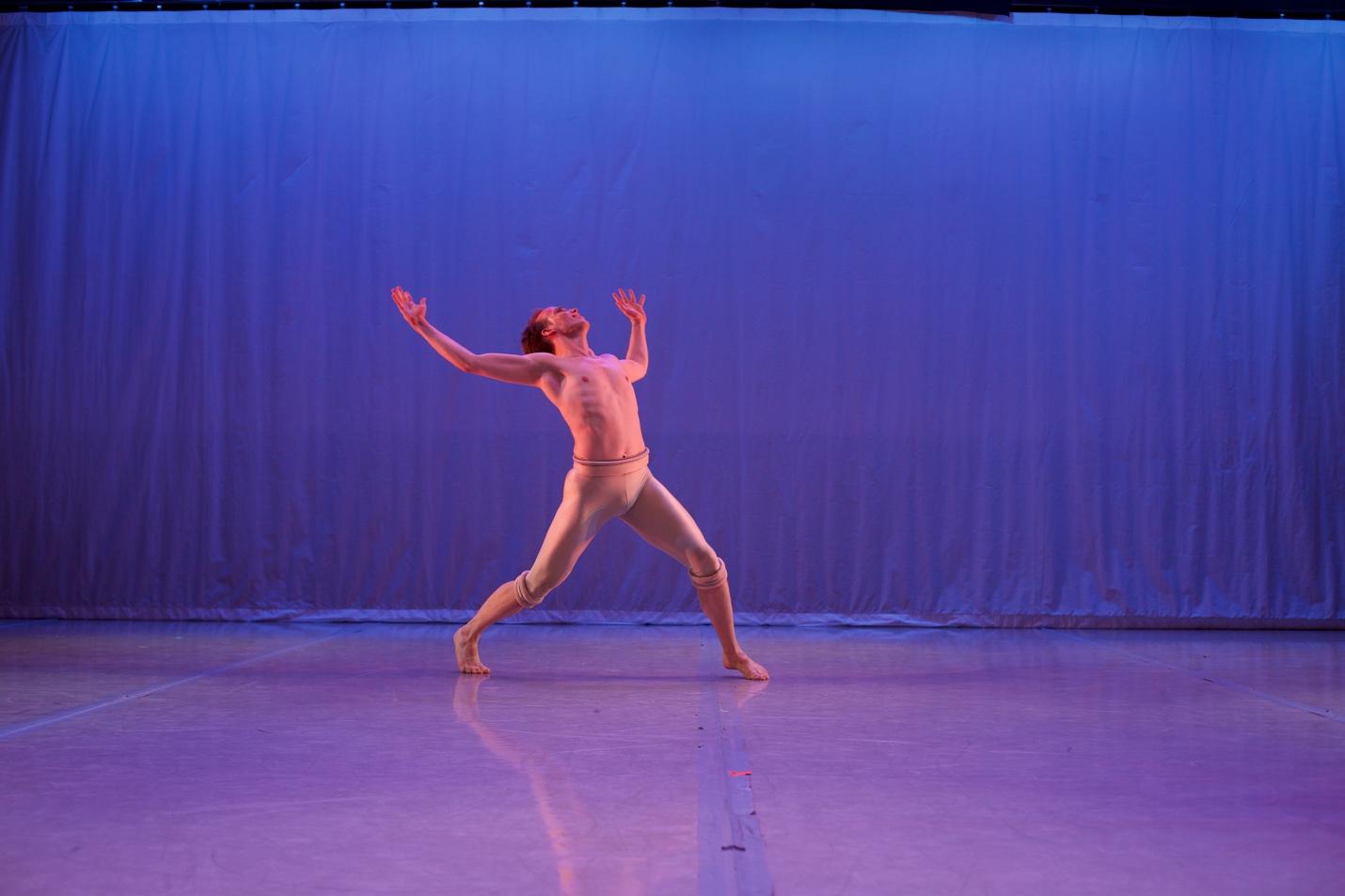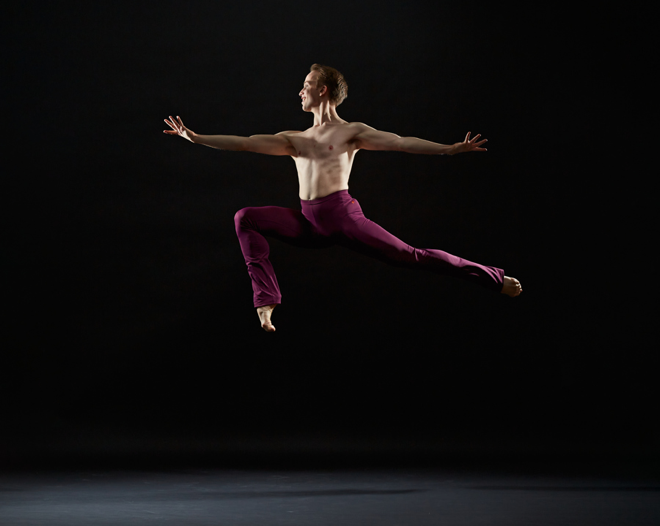Kenopsia. Photo by Melissa Sherwood
Opinions expressed by Digital Journal contributors are their own.
Gion Treichler’s path through the world of dance is a compelling narrative of passion, dedication, and the transformative power of collaboration. His commitment to the art form led him to pursue contemporary dance, culminating in his training at Zurich University of the Arts (ZHdK). Throughout his illustrious career, Gion has not only graced stages across the globe but also worked closely with a slew of renowned choreographers, enriching his repertoire and elevating his performance to unparalleled heights.
Gion’s artistry blossomed further during his tenure with Graham 2 in New York City, where he adeptly navigated Martha Graham’s legendary choreography and collaborated with contemporary masters. Today, as a celebrated member of Dance Kaleidoscope in Indianapolis, he continues to mesmerize audiences, interpreting the works of choreographic visionaries with unmatched passion and precision.
His journey, marked by significant collaborations, underscores the importance of synergy in the dance world, spotlighting Gion’s esteemed status among peers and mentors.
Early beginnings and influential partnerships
Gion has always had a passion for dance. “What initially sparked my passion for dance was an innate desire that I’ve carried with me for as long as I can remember,” Gion recalls. Despite exploring various hobbies and sports, it was the unique allure of dance that truly resonated with him, leading to a profound realization.
“The realization that one could pursue dance as a viable career path ignited a sense of clarity within me; I knew instantly that this was the path I wanted to follow,” he explains.
This clarity led Gion to the Zurich Dance Academy, where he embarked on a rigorous journey that shaped his future. Over three years, he completed the Basic Studies Program before advancing to the Ballet School of the Opera House Zurich. “Understanding that success in the dance world requires unwavering
dedication and relentless effort, I embraced the challenge wholeheartedly,” he shares. This commitment to mastering his technique and skills laid the groundwork for his aspiration to become a professional dancer. His early experiences at these prestigious institutions not only honed his abilities but also solidified his determination to make a significant impact in the world of dance.
Collaborative highlights: The Portugal influence
One of the most memorable collaborations in Gion’s career was with Filipe Portugal during their time together at the Ballet School of the Opera House Zurich. Gion recalls the impact of working with Portugal, who was a principal dancer with Ballett Zurich at the time. “Working alongside Filipe, such as in his piece ‘Under Duress,’ was an unparalleled experience,” he explains, emphasizing both Portugal’s exceptional prowess as a dancer and his profound insights into choreography and movement. Gion admired Portugal’s meticulous and innovative approach, which consistently pushed the boundaries of artistic expression.
This collaboration was not only professionally enriching but also personally significant for Gion. He describes the supportive working environment that Portugal fostered: “Filipe’s encouragement and approachability were evident throughout our collaboration, fostering a dynamic and supportive working environment.” As a mentor, Portugal shared his wealth of knowledge, greatly contributing to Gion artistic growth. Reflecting on their work together, especially on Portugal’s version of “Afternoon of a Faun,” Gion notes, “Our collaboration not only enhanced my professional journey but also left a lasting impact on my personal development.” He expresses deep gratitude for the opportunities to collaborate with Portugal and the profound influence those experiences had on his evolution as an artist.
The art of adaptation
Gion emphasizes the importance of openness and adaptability in building creative synergy with choreographers whose styles or visions differ from his own. “Establishing common ground and fostering creative synergy with choreographers whose styles or visions differ from my own is an essential skill honed throughout a dancer’s training,” Gion explains.
He approaches each collaboration with an open mind and a willingness to adapt, appreciating the unique perspectives and backgrounds that each choreographer brings to the table. This curiosity drives him to delve deeply into different choreographic styles and dance backgrounds, enabling a richer understanding of their approaches to movement and expression.
Gion employs a proactive strategy to align with the choreographer’s vision more effectively. “An effective strategy I employ is to actively engage with the choreographer, seeking clarification and insight into their intentions,” he shares. Requesting demonstrations and clarifications helps him to precisely grasp their expectations, while their use of metaphor or real-life examples provides valuable context and perspective. “Ultimately, my goal is not to impose my own style or vision but to collaborate harmoniously,” Gion states. By embracing this method, he enhances the artistic process and fosters mutual respect and appreciation for the distinctive contributions of each collaborator.
Overcoming interpretative challenges
The significant challenges of transitioning from the rigidity of traditional dance techniques to the more fluid demands of contemporary choreography are described by Gion. “Navigating the transition from traditional dance techniques to the fluidity of choreography poses one of the most significant challenges I’ve encountered,” he notes. In classical ballet, the structured framework of established rules provides clear guidelines, but contemporary choreography often eschews these conventions for greater creative freedom. Gion highlights the difficulty in adjusting to such differences, explaining, “One of the key hurdles I’ve faced is relinquishing the constraints of traditional techniques and embracing the choreographer’s vision, even when it contradicts established norms.”
To manage these challenges, Gion has developed several effective strategies. “Engaging in extensive rehearsal and deliberate practice allows me to internalize and integrate the choreographer’s instructions more effectively,” he states. Additionally, cultivating mindfulness and presence during performances helps him adapt to the demands of fast-paced choreography with greater agility. “Embracing a mindset of openness and flexibility has been paramount in overcoming these challenges,” Gion reflects. By adopting this approach, he ensures that he can merge technical precision with artistic expression, successfully bringing the choreographer’s vision to life on stage.
Growth through new ventures at Dance Kaleidoscope
Transitioning to Dance Kaleidoscope in Indianapolis and participating in productions such as “New Horizon,“ “Divas A New,“ “Intimate DK,“ and “New Voices“ have been a pivotal point in Gion’s dance career. The opportunity to work within this dynamic company allowed him to dive deep into an array of new performances, enriching his experience and broadening his artistic perspectives.
In particular, Gion values the exposure to new artistic voices and the creative exchange with choreographers and dancers from diverse backgrounds. “Collaborating with choreographers and fellow dancers who bring diverse backgrounds and influences to the table has broadened my artistic horizons,” he explains. This influx of new ideas and creative methodologies has not only enhanced his repertoire but also deepened his appreciation and understanding of dance as a profound form of expression.
Performing on new stages and engaging with different audiences further refined his skills, presenting unique challenges that fostered his adaptability and growth as an artist. “The experience of connecting with audiences in Indianapolis has offered fresh insights and perspectives, further enhancing my performance capabilities,” Gion notes, underscoring the comprehensive impact of his recent experiences on his overall artistic development.
Behind the scenes
Gion offers a fascinating glimpse into the rehearsal process with choreographer Yoshito Sakuraba, revealing a less conventional approach to dance creation that may surprise those unfamiliar with the dance world.
He explains, “A notable aspect of his method that might surprise those outside the dance world is the utilization of improvisation as a fundamental tool for generating movement material.” Unlike the rigid structure often associated with choreography, Yoshito embraces a highly collaborative process, encouraging dancers to be active participants in developing the choreography.
During these rehearsals, Yoshito engages the dancers in improvisation sessions, where he provides prompts or thematic concepts that inspire the creation of movement. “This improvisational approach encourages dancers to tap into their individual artistic instincts and expressiveness, fostering a sense of ownership and investment in the choreographic process,” Gion shares. Additionally, Yoshito emphasizes embodied storytelling, urging dancers to infuse their movements with personal narratives and emotional depth, thus challenging the traditional view of choreography as merely aesthetic and emphasizing the importance of authenticity and resonance in movement expression.
Peer influence in creative processes

In the collaborative environment of dance, interactions with fellow dancers significantly impact Gion’s performance and deep understanding of the choreographies he engages with. Reflecting on his experience during the rehearsals for “Tea for Two” under David Hochoy, Gion notes, “His frequent references to the Graham technique resonated with me, leveraging my existing familiarity with it.” This specific guidance helped clarify intricate steps and provided emotional context through character references from Martha Graham’s repertoire, thereby enriching his interpretation of the piece.
Another instance where peer interaction played a crucial role was during rehearsals for Bradley Shelver’s “Under Their Breath.” Gion struggled with executing a turn in plié, which was promptly addressed by Shelver. “Bradley’s keen eye immediately detected the issue and provided timely corrections,” Gion recalls, highlighting the benefits of working closely with peers who possess a dual role as choreographers and dancers. This collaborative process not only helped refine his technique but also enriched his artistic journey, allowing him to draw on the vast experience of his peers to elevate his overall performance.
Future collaborations
Gion expresses a keen interest in collaborating with Crystal Pite, a choreographer whose work has profoundly impacted him. “There are numerous choreographers whom I aspire to collaborate with, but one in particular stands out: Crystal Pite,” Gion states. He is drawn to Pite’s work for its emotional depth and the seamless integration of technical precision with raw emotional intensity, which he finds captivating on stage. “Her choreographic language is captivating, often transcending traditional boundaries to explore the depths of human experience,” Gion explains, highlighting the unique appeal of her narrative approach and technical mastery.
“I am consistently inspired by the depth and complexity of her storytelling, as well as the profound emotional resonance inherent in her choreography,” he notes. Pite’s innovative approach to movement and narrative, which challenges conventional notions of dance, also resonates with Gion. “Her willingness to explore themes of vulnerability, connection, and human frailty speaks to me on a deeply personal level,” Gion shares, emphasizing his desire to delve deeper into the expressive potential of dance through potential collaborations with innovative artists like Pite.
In tracing Gion’s journey, it is evident that his successes and evolution as a dancer are inextricably linked to his collaborations with a diverse array of choreographers. These partnerships have not only shaped his artistic identity but have also highlighted the indispensable role of collaboration in the dance world. As Gion continues to captivate audiences with his interpretive prowess, his narrative serves as a compelling testament to the symbiotic relationship between dancer and choreographer, and the boundless possibilities it engenders in the pursuit of artistic excellence.

